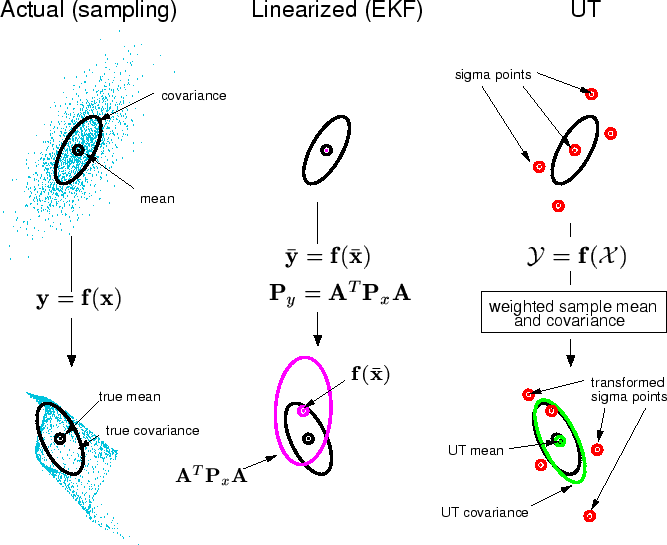Overview¶
- Observability of nonlinear systems
- EKF: Extended Kalman Filter for nonlinear system
- EKF vs UKF
Observability matrix¶
Observability for nonlinear system \( \dot{X} = f(X) + g(X)u \) with measurement \( y = h(x) \) is given by
is given by,
$$ O(f,h) = [ L^0_fh^T~ L^1_fh^T~ L^2_fh^T~ \dots ~ L^{n-1}_fh^T] $$If the observability matrix above has a full rank, then the states of the system can be estimated. Note, observability matrix may lose rank in some state-space and could potentially become unobservable.
Extended Kalman Filter (EKF)¶
Consider the nonlinear system given by,
$$ X_{k} = f(X_{k-1}) + w_{k-1} $$with measurement
$$ Z_{k} = h(X_{k}) + v_{k} $$where \( w_k\) and \( v_k \) represent process and measurement noise with means 0 and covarances given by \(Q_k\) and \(R_k\). We further assume that state covariance is given by a matrix \( P \). Detailed derivation of extended kalman filter can be found here. The EKF is implemeted in the following steps.
Forecasting step¶
$$ \hat{X}_{k}^- = f(\hat{X}_{k-1}^+) $$$$ P_{k}^- = \frac{\partial f}{\partial X} P_{k-1}^+ \frac{\partial f}{\partial X}^T + FQ_{k-1}F' $$where the partial derivatives are evaluate at \( X_{k-1}^+ \).
Correction step¶
$$ K_k = P_{k}^- \frac{\partial h}{\partial X}^T \left( \frac{\partial h}{\partial X} P_{k}^-\frac{\partial h}{\partial X}^T + R_k \right)^{-1}$$$$ P_k^+ = \left( I - K_k \frac{\partial h}{\partial X} \right)P_{k}^- $$The partial derivatives are evaluated at \( X_{k}^- \).
$$ X_k^+ = X_k^- + K_k(Z_k - h(X_k^-)) $$Unicycle example:¶
Consider the dynamics of a unicycle car moving along a straight line at angle of 45-degrees.
$$ \dot{x} = V cos(\theta) $$ $$ \dot{y} = V sin(\theta) $$ $$ \dot{\theta} = \omega $$Discretizing,¶
$$ x_{k+1} = x_k + \delta t(V_k+w_v) cos(\theta) $$ $$ y_{k+1} = y_k +\delta t(V_k+w_v) sin(\theta) $$ $$ \theta_{k+1} = \theta_k + \delta t(\omega_k+w_\omega) $$Separating noise and state terms gives,¶
$$ \left[ \begin{array}{c} x_{k+1} \\ y_{k+1} \\ \theta_{k+1} \end{array} \right] = \left[ \begin{array}{c} x_k + \delta t V_k cos(\theta) \\ y_k +\delta tV_k sin(\theta) \\ \theta_k + \delta t \omega_k \end{array} \right] + \left[\begin{array}{cc} \delta t cos(\theta) & 0 \\ \delta t sin(\theta) & 0 \\ 0 & \delta t \end{array} \right] \left[\begin{array}{c} w_v \\ w_\omega \end{array} \right] $$clc
close all
clear all
dt = 0.001;
v = .5;
head_ang = pi/4;
C = [1 0 0;
0 1 0];
R = diag([.001 .001]);
Q = diag([.1 .01]);
P_pl = eye(3);
X_hat_0 = [0;0;0];
X_0 = [.1;.1;head_ang];
X_hat_0 = X_0/2;
X(:,1)= X_0;
Y(:,1) = C*X(:,1);
t(1) = 0;
X_hat(:,1)= X_hat_0;
for i = 1:4000
u = [.5;0];
t(i+1) = t(i)+dt;
% True process
X(:,i+1)= X(:,i) + dt*[u(1)*cos(X(3,i));
u(1)*sin(X(3,i));
u(2);];
Y(:,i+1) = C*X(:,i+1) + sqrt(R)*randn(size(C,1),1); %*randn(2,1);
% Observer model
dFdx = [0 0 -v*sin(X_hat(3,i)); 0 0 v*cos(X_hat(3,i)); 0 0 0 ];
dFdx_d = eye(3) + dt*dFdx;
F = [dt*cos(X_hat(3,i)) 0;
dt*sin(X_hat(3,i)) 0;
0 dt];
P_mi = dFdx_d*P_pl*dFdx_d' + F*Q*F';
X_hat(:,i+1) = X_hat(:,i) + dt*[u(1)*cos(X_hat(3,i));
u(1)*sin(X_hat(3,i));
u(2);];
Y_hat(:,i+1) = C*X_hat(:,i+1);
% Update based on measurement
e_Y = Y(:,i+1) - Y_hat(:,i+1);
S = C*P_mi*C'+R;
K = P_mi*C'*inv(S);
P_pl = (eye(3) - K*C)*P_mi;
X_hat(:,i+1)=X_hat(:,i+1) + K*e_Y;
end
X_hat(3,1) = X_hat(3,end);
P_pl = P_mi;
figure;
subplot(2,1,1)
plot(t,X(1,:),t,X_hat(1,:),'--')
legend('true','estimate')
%axis([0 2.5 0 40])
xlabel('time')
ylabel('X')
axis([0 4 0 2])
subplot(2,1,2)
plot(t,X(2,:),t,X_hat(2,:),'--')
legend('true','estimate')
xlabel('time')
ylabel('Y')
axis([0 4 0 2])
figure;
plot(t,X(3,:),t,X_hat(3,:),'--')
axis([0 4 0 1])
xlabel('time')
ylabel('Theta')
%axis([0 2.5 0 2])
Conclusion: Extended Kalman filter.¶
- Works well for most nonlinear systems
- Calculating apriori covariance requires linearization approximation, which may not be true.
- For highly nonlinear systems, can result in erroneous estiamtes
Unscented transform¶
- Unscented transforms are used to obtain a better estimate of covariance matrix
- Choose some sigma points, propagate state and compute new covariance directly
